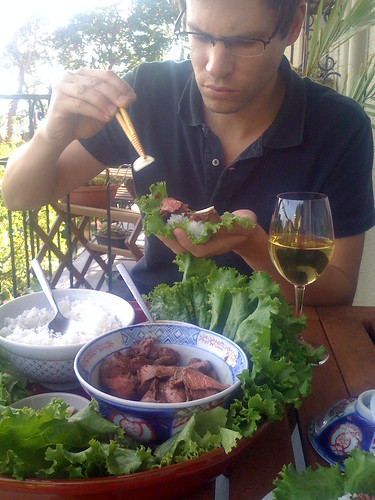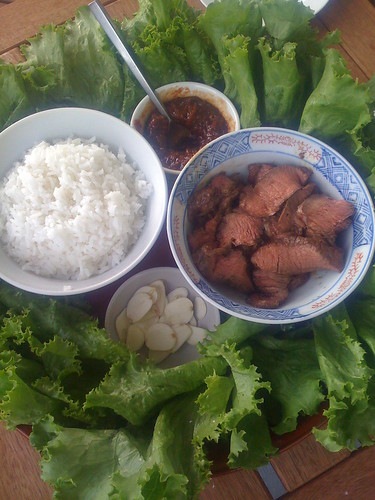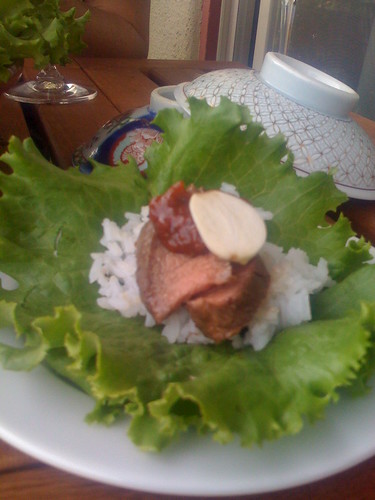Ssam -Korean for “to wrap”, is an ideal summer dinner; light, quick to make, and of course the opportunity to play with your food. The idea is that you wrap something, traditionally rice, garlic, and ssamjang in lettuce, fold the leafy green over into a nice little bundle and eat.
Versions of the dish are endless, you can use just about any small slices of meat, think slab bacon, thinly sliced steak, chicken tenders. Raw fish: salmon, tuna, or lightly sauteed shrimp.  Vegetables: crunchy jicima, roasted sweet potato and parsnips, cucumber or shredded red cabbage. Wrap with green leaf lettuce, butter leaf or sesame leaf. If you don’t dig ssamjang, try ssam with hoisin or harissa, sirracha or mango chutney even.
Ultimately, this could be a brilliant use of leftovers and condiments housing just a couple tablespoons of product. Pull it all out of the fridge, make some rice, wash lettuce, and viola, dinner.
After last night’s dinner of construct your own spring rolls (there is a theme here), I had a craving for more hoisin sauce. In an effort to tone down ssamjang’s punchy pungency, I decided to combine hoisin and ssamjang. The result? Delicious.  All the flavor notes were hit, sweet from the hoisin, the spicy, salty, and sour from the ssamjang.
Flat Iron Ssam
1 cup short grain sticky rice
1 Flat iron steak, trimmed of silver skin (flank steak works too)
Kosher salt and pepper
1 TBSP canola oil
1 head green leaf lettuce
3 cloves garlic
1/3 cup ssamjang
2 TBSP hoisin Sauce
teriyaki or bulgogi or Asian BBQ sauce optional*
1. Cook rice in a rice cooker or on the stove.
2. Preheat oven to 400 degrees F. Season steak with salt and pepper on each side and cut in half (I only do this because me frying pan is too small to accomodate the steak whole. If yours is big enough or if you are grilling your steak, then by all means, don’t cut it). Heat a sauté pan with 1 TBSP canola oil until pan until shimmering. Place steak halves in pan and sear until nice and brown on each side (about 2-3 minutes per side). Immediately transfer pan into preheated oven and cook until an internal temperature of 140 degrees is reached. About 10 minutes, sometimes more, sometimes less. Remove steaks from the pan and let sit on the cutting board to rest at least 5 minutes.
3. Separate lettuce, wash leaves, and tear off the bottom crunchy bit. Arrange leaves around a large platter.
4. Peel and slice garlic cloves uber thin. Place in a small serving dish and set on platter.
5. In a small ramekin mix together the ssamjang and the hoisin, adjusting by adding more of either until a desired taste is reached.
6. Transfer cooked rice to a serving vessel and place on platter with a serving spoon.
7. Cut the meat ¼ inch thick on the diagonal for thin slices. Place in a bowl with all the yummy juices that have escaped and place on serving platter.
8. Set table with platter, small individual plates, and chop sticks for everyone
Chef’s Notes.
Other condiments that can work if you don’t have ssamjang, are mixing together gochu jang and doenjang, or using a chunky dark miso, or use hoisin and sriracha, or harissa whatever your tastes are.
If you want to further flavor your meet, before transferring pan to oven, pour enough teriyaki, bulgogi, or Asian BBQ sauce over the meat to cover. Turn once while cooking.
To eat ssam, place one leaf of lettuce on your plate, top with a golf ball size of rice. Flatten it out a bit to make a nice surface for which to place a couple slices of meat. Top with a spoonful of ssamjang or other sauce and one or two slices of garlic. Wrap up into a nice little package, less burrito like and more envelope style. Open up and enjoy!



Looks yummy! I think we need a field trip to the International District to purchase a few wee items!!
are you back in Seoul???
What a great idea for left-overs! This looks delish!
I would love to include your recipe in our pre-loaded Demy, the first and only digital recipe reader. Please email haleyglasco@gmail.com if you’re interested.
To find out more about the Demy, you can visit this site:
http://mydemy.com/
Thanks!
hi
i love your blog. i am a frequent visitor & i am an indian.
i have a question , i watch lot of korean dramas their they
serve lot of side dishes do they make it everyday or make
ahead & keep in the fridge. if that is the case how they
could reheat it or eat it cold. i know lot of questions but
i don’t have any korean friend to ask. i’m a working mom &
i want to feed my family well like korean do. pl help me
thanks a lot in advance.
suji